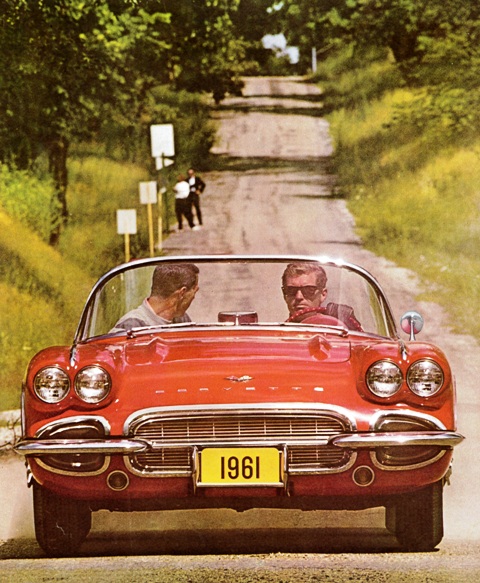By: Robert Tate, Automotive Historian/Researcher
Images: Courtesy of Robert Tate's Collection
Posted: 09.09.2015
The 1961 Corvette was a sleek, two-passenger model sports car that most car enthusiasts enjoyed.
The revised styling of the Corvette for 1961 reflected the influence of Chevrolet's designed concept car —the XP-700 experimental vehicle that was a part of General Motors' Bill Mitchell's design team at the GM Technical Center in Warren.
The XP-700 show car was used for the auto show highlights and displays beginning in October of 1959 and had become a popular attraction. The Corvette advertising called the 1961 Corvette models “Excitement in standard equipment.” The performance was great and the body exterior was personalized to sports car owners' needs.
 1961 CorvetteThe Corvette design was changed in 1961. Whether the change was advantageous was a matter of taste or distaste if the consumers. The 1961 Corvette was a product of careful craftsmanship and creative engineering as world's finest sports car in its performance class at a price of $3,934. In 1961, five Corvette models were entered in the Sebring twelve-hour race in March. This was great way for General Motors to show off the Chevrolet Corvette models' style and handling performance for race car fans.
1961 CorvetteThe Corvette design was changed in 1961. Whether the change was advantageous was a matter of taste or distaste if the consumers. The 1961 Corvette was a product of careful craftsmanship and creative engineering as world's finest sports car in its performance class at a price of $3,934. In 1961, five Corvette models were entered in the Sebring twelve-hour race in March. This was great way for General Motors to show off the Chevrolet Corvette models' style and handling performance for race car fans.
 1961 CorvetteStyling for 1961 Corvette models was a mild face-lift of the 1960 models and it was highly admired by many automotive fans. The models maintained a strong family resemblance, even with the new lattice type grille in the front and an ultra-continental treatment to the rear half of the car.
1961 CorvetteStyling for 1961 Corvette models was a mild face-lift of the 1960 models and it was highly admired by many automotive fans. The models maintained a strong family resemblance, even with the new lattice type grille in the front and an ultra-continental treatment to the rear half of the car.
The 1961 Corvette models offered a rear ducktail design that was first shown on the racing Stingray and the XP-700 show car. The rear fenders were more pronounced while the fiber glass body surface had a new sculptured effect above the modified bumpers. The body exterior was made of fiber glass reinforced plastic with sculptured side and rear panels and contained a front hinged hood along with dual headlights and four taillights and push button door handles. The 1961 models also offered a large luggage area with a spare tire under the floor. The convertible top came standard as a power-operating top, but a detachable hardtop was available in place of the convertible top at no extra cost.
 1961 CorvetteOn the Corvette interior styling, the nicely designed two-seat cockpit offered the driver and its passenger more interior room along with great color schemes that were available in black, red, fawn, and blue with foam rubber padded all vinyl trimmed bucket seats for the driver and passengers. Other features included safety belts along with a transistorized push button signal radio and a heater.
1961 CorvetteOn the Corvette interior styling, the nicely designed two-seat cockpit offered the driver and its passenger more interior room along with great color schemes that were available in black, red, fawn, and blue with foam rubber padded all vinyl trimmed bucket seats for the driver and passengers. Other features included safety belts along with a transistorized push button signal radio and a heater.
 1961 CorvetteSome auto enthusiasts regard the 1961-68 Corvette models as the best Corvette models since the classic 1957 models.
1961 CorvetteSome auto enthusiasts regard the 1961-68 Corvette models as the best Corvette models since the classic 1957 models.
"Continual refinements since 1954 have made the Corvette into a sports car for which no owner need make excuses," as stated in an article from Road & Track magazine. With sales rising in 1961, Corvette offered a slight increase in the model-year production with a total of 10,939 units that became available for the consumer market proving the sports car’s powerful influence on the auto industry and the corvette consumers. Today, the 1961 Corvette spirit is still alive among collectors and enthusiasts.

A special thanks to Robert Tate, Automotive Historian and Researcher, for donating the story to the MotorCities Story of the Week program. Photographs are courtesy of Bob Tate’s Collection. (Bibliography: Automobile Quarterly Publications. “Corvette America's Star-Spangled Sports Car the Complete” History by. Karl Ludvigsen”. 1974. The Auto Editors of Consumer Guide. “Corvette 50th Anniversary” 2003. General Motors. 1961 Chevrolet Corvette sales catalog.)
Please do not republish the story and/or photographs without permission of MotorCities National Heritage Area. If you would like to contribute an article for the MotorCities newsletter, email This email address is being protected from spambots. You need JavaScript enabled to view it. or call 313-259-3425.



